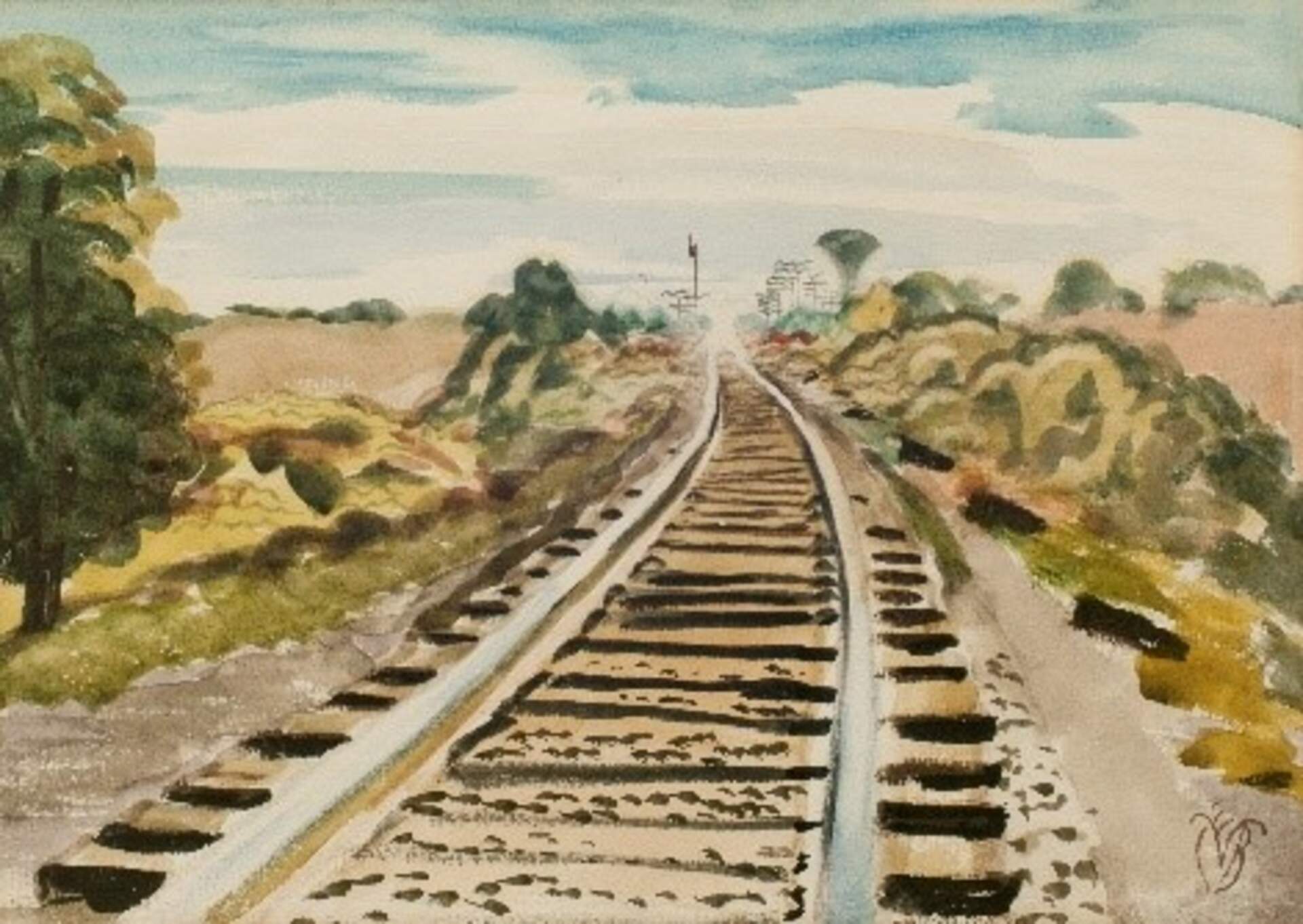Charles E. Burchfield (1893-1967)Heat Waves (also known as Railroad Track in September)
1932
watercolor and pencil on paper
10 ¼ x 15 inches
Burchfield Penney Art Center, Gift of Peter C. Andrews and Joan K. Andrews, 2018
Charles Burchfield painted 23 paintings in 1932, according to Joseph S. Trovato in the book he edited, Charles Burchfield: Catalogue of Paintings in Public and Private Collections, published in 1970. However, recent research suggests that one painting was listed under two different titles. Railroad Track in September is listed as catalogue number 803, size 10 ½ x 15 inches, provenance “James Goodman Gallery.” James Goodman had exhibited the work in 1962 in his gallery at the Park Lane in Buffalo, New York. Interestingly, Trovato lists Heat Waves, catalogue number 796, size 11 x 14 ½ inches, with the provenance “Artist (1942);” but he also lists an earlier catalogue number of 625 assigned by John W. Straus for his 1942 honors thesis at Harvard University, titled “Charles E. Burchfield: An Interview with the Artist, and Account and Analysis of His Production, and a Catalogue of His Paintings.” Straus was the first undergraduate allowed to do his thesis on a living artist. So why do I think they are one in the same?
Railroad Track in September has no Straus number, but on the back of the framed painting a label notes that the painting had been “Ex-collection W. Pach.” Charles Burchfield met Walter Pach in October or November 1916, when he briefly lived in New York to attend the National Academy of Design. Pach was already well known for organizing exhibitions of modern art, including helping Arthur B. Davies to produce the International Exhibition of Modern Art, known better as “The Armory Show.” This landmark exhibition, held in 1913, included Henry G. Keller, who was Burchfield’s Cleveland School of Art teacher and mentor. It would have been quite an honor to have Pach—a distinguished critic, art historian, and painter—acquire a painting, especially decades later.
In the 1950s, Burchfield created a multi-volume Painting Index, which documents works from 1914 through 1954. Some, but not all, entries are illustrated with black and white photographs. Railroad Track in September is not included in Volume VIII, which covers work from 1930 through 1932. However, a watercolor painting titled “Heat Waves” is catalogued as Vol. VIII-48, created in 1932, size 11 x 15 inches, unillustrated. Burchfield noted that the location or subject was “PENNA. RAILROAD – NEAR MACHIAS, N.Y.” and that it was in the collection of “PACH” having been “GIVEN AT HIS REQUEST FOR LARGE PHOTO OF ME. (NEVER ACKNOWLEDGED).” The watercolor Railroad Track in September clearly depicts “Heat Waves” in the distance—and its label documents that it had been owned by Walter Pach. Dealers who do not have access to an artist’s primary information, such as titles, will often create a descriptive title based on subject matter. This appears to be the case with Burchfield’s self-titled Heat Waves that later became Railroad Track in September. The original title is a distinct message to feel the steaming hot, late summer day as you scan the train route until it vanishes in a distorted haze of white light and shimmering telephone poles.
— Nancy Weekly, Burchfield Scholar, June 25, 2019
Addendum: On July 3, 2019 I found Burchfield's hand-written manuscript dated September 2, 1932 that describes the day he painted this work. It is transcribed below:
Charles E. Burchfield, “Sept. 2 - 1932,” hand-written manuscript
Burchfield Penney Art Center, Charles E. Burchfield Archives, Gift of Charles Rand Penney, 1994
Sept. 2 – 1932
- - - - On the railroad; the sweltering noon heat comes up in waves from the railroad; cicadas’ songs fill the air, to the south a beautiful phenomenon. The glistening rails like molten silver, converging into a mass of heat waves which are so dense that they produce a mirage like illusion, and become like a little pool, reflecting the sky, and therefore like bluish white smoke, writing, now swelling, now shrinking -
Start a painting of the scene, but a freight train from the north interrupts me; a long line of cars with one locomotive in front, and two in the rear. It disappears in the “heat-wave pool” as into a fog — with this difference: it was reflected in the “pool”, as also was the smoke so that more than ever it seemed like a smoldering fire. – Shortly afterward a train came from the south, appearing suddenly out of the heat-waves like a black apparition.
— Nancy Weekly, Burchfield Scholar, July 3, 2019
